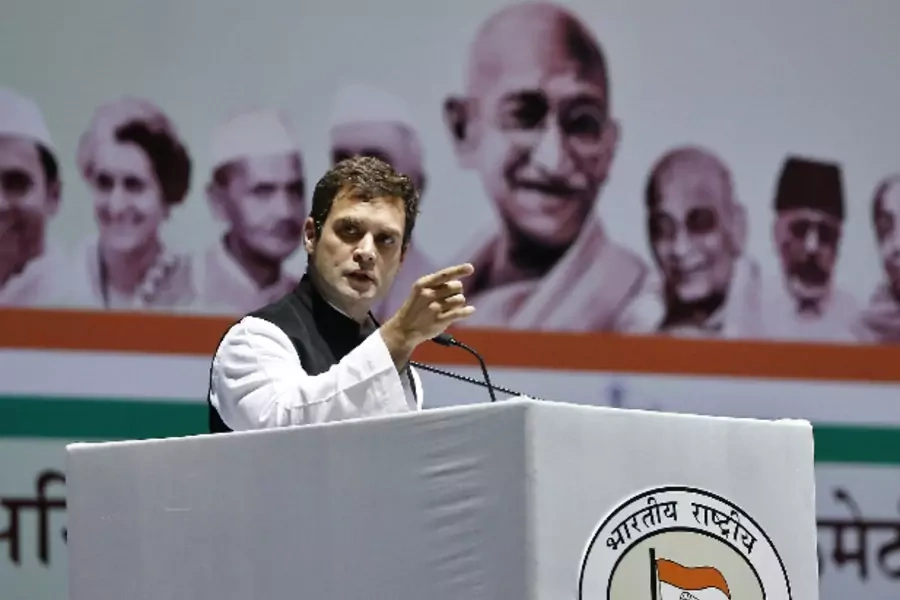More on:
This post is part of a series on the Indian elections.
On Monday, January 27, Indian National Congress party vice president and heir apparent Rahul Gandhi sat down for a lengthy one-on-one interview with India’s most-watched gotcha television host, Arnab Goswami (transcript here, and video here). His first in-depth interview in his nearly ten years as a member of parliament—and two years as the front face of Congress’s election campaigns—marks a new effort to make Mr. Gandhi more publicly accessible. Reportedly this is one prong of a new media strategy for Mr. Gandhi as India prepares for national elections by mid-April.
Much of the social media and television talk show post-mortems have focused on the repetitive, indirect, and under-specific nature of Mr. Gandhi’s answers to Mr. Goswami. He emphasized wanting to change the system, putting into place new democratic processes, empowering women, and seeking to make India more open and transparent. He mentioned the ruling United Progressive Alliance (UPA) government’s Right to Information Act, and stressed his efforts to reform the Congress Party’s internal mechanisms for candidate selection to allow something more akin to primaries and open elections. As one commentator said on a primetime talk show, The Last Word, these are all commendable and unexceptionable goals. What analysts have found curious was Mr. Gandhi’s reliance on these goals and principles to answer most if not all of the questions posed. The ultimate test, of course, will come this spring at the ballot box.
From an outsider’s perspective, the question of democratic systems and the way they function in India remains a larger puzzle. Why haven’t more parties in India pushed for more open systems and processes? Because the Indian political system in general does not have internal party primaries, would-be candidates vie for the blessings of party “high commands” in order to be able to stand for election as a party member. (It’s called “receiving a ticket” to stand for election). This means, for example, that a slate of candidates for any particular election gets decided in a closed meeting of senior party officials without the direct input of voters.
One result of a system structured without internal party primaries has been the proliferation of parties themselves. Breakaway factions become not “wings” of established parties, but rather, entirely new parties. (It would be as if the Tea Partiers formed a new party themselves, rather than contesting under the Republican umbrella). This can be seen with the creation of the YSR Congress in Andhra Pradesh, or the Trinamool Congress in West Bengal, or the Nationalist Congress Party in Maharashtra and Meghalaya. Going back further, in Tamil Nadu the All-India Anna Dravida Munnetra Kazhagam broke away from the Dravida Munnetra Kazhagam, which itself had broken away from the Dravidar Kazagham, which had broken away from the Congress party in 1925. Or take the Balkanization of the Janata Dal into the Samajwadi Party, the Rashtriya Janata Dal, the Biju Janata Dal, and the Janata Dal (Secular) and Janata Dal (United).
While not every political party in India originated as an offshoot (the sui generis Shiv Sena, Akali Dal, Bahujan Samaj Party or Telugu Desam Party come to mind), a brief scan of registered parties in India reveals sheer scale in numbers. India has, at present, six national parties, and twenty-two state parties. There are now more than 1500 registered “unrecognized” smaller parties as well (here for 1-1300+; here, here, and here for the 200+ additions). In any given state, the practical effect presents an array of choices for voters—but also a fracturing, often, of a political mandate. That’s because India has a parliamentary system, so a party winning a mere plurality of voter support could end up forming a government, nationally or at the state level, by cobbling together enough of a coalition to reach the halfway mark. The National Democratic Alliance coalition government from 1998 to 2004 included twenty-four parties at its peak. The UPA governments (2004 to 2009, and 2009 to present) have had as many as twelve parties in the coalition, plus “outside support” from the Left Front (a collection of communist parties), the Samajwadi Party, the Bahujan Samaj Party, and other small parties at different times.
India has not had a single-party led government since 1989, suggesting the institutionalization of large coalitions. During the 1990s, coalitions appeared less stable, but that no longer appears to be the case. Governments no longer fall early due to wayward coalition partners—because many fear losing in a reelection—but policies do suffer. One lesson from the ten years of UPA government might be the difficulty in steering forward policies of even the slightest controversy: the UPA lost the Left Front during its first term over the civil nuclear agreement with the U.S., and in its second term lost the Trinamool Congress and the Dravida Munnetra Kazhagam over policies on foreign investment in retail and on human rights in Sri Lanka, respectively.
Of course, a more consolidated system with fewer parties and open challenges within parties might not end policy deadlock. The U.S. Congress makes a fine case in point, with two national parties still hard-pressed to pass legislation quickly on matters as mundane as the United States budget. (On the budget front, the Indian system performs admirably and reliably, with no fear of government shutdown!). Still, I’ve long been perplexed why a larger discussion on the merits of internal party primaries and a system open to any candidate who can spark voter interest and support does not generate much public debate in India. Maybe Mr. Gandhi has done a service by getting it started.
Follow me on Twitter: @AyresAlyssa
More on:
 Online Store
Online Store
